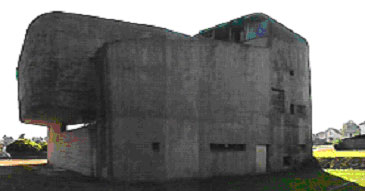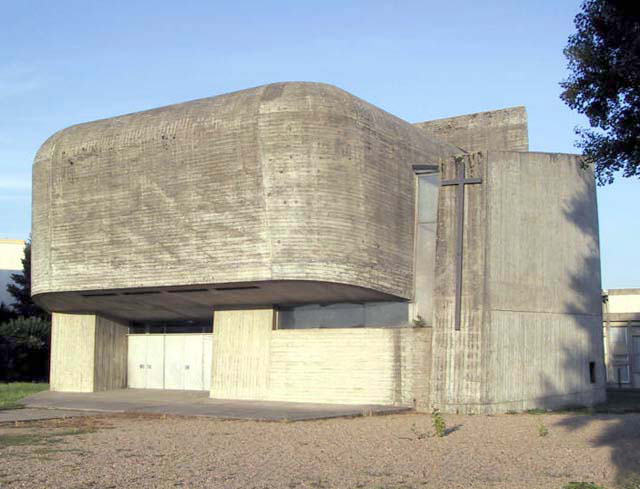
Sainte-Bernadette du Banlay. Nevers, France (1966) Paul Virilio and Claude Parent

Built to withstand a 30 Megaton warhead.
In Bunker Archeology, urban philosopher and cultural theorist Paul Virilio turns his attention—and camera—to the ominous yet strangely compelling German bunkers from WW II that lie abandoned on the coast of France. These ghostly reminders of destruction and oppression prompt Virilio to consider the nature of war and existence, in relation to both the Second World War and contemporary times.
Thus, according to Virilio, the fortified city of the feudal period was a stationary and generally unassailable 'war machine' coupled to an attempt to modulate the circulation and the momentum of the movements of the urban masses. Therefore, the fortified city was a political space of habitable inertia, the political configuration, and the physical underpinning of the feudal era. Nevertheless, for Virilio, the essential question is why did the fortified city disappear? His rather unconventional answer is that it did so due to the advent of ever increasingly transportable and accelerated weapons systems. For such innovations 'exposed' the fortified city and transformed siege warfare into a war of movement. Additionally, they undermined the efforts of the authorities to govern the flow of the urban citizenry and therefore heralded the arrival of what Virilio (Virilio and Parent, 1996: xv) calls the 'habitable circulation' of the masses. Unlike Marx, then, Virilio postulates that the transition from feudalism to capitalism was not an economic transformation but a military, spatial, political, and technological metamorphosis. Broadly speaking, where Marx wrote of the materialist conception of history, Virilio writes of the military conception of history.
Beginning in 1958 with a phenomenological inquiry into military space and the organization of territory, particularly concerning the 'Atlantic Wall' ? the 15,000 Nazi bunkers built during World War II along the coastline of France to repel any Allied assault ? Virilio deepened his explorations within the Architecture Principe group. An absolutely crucial but somewhat overlooked aspect of Virilio's work from the beginning is his continuing allegiance to a psychologically based gestalt theory of perception.3 This theory was not only chiefly responsible for Virilio and Parent's development of the concept of the 'oblique function' but also for their construction of the 'bunker church' in Nevers in 1966 and the Thomson-Houston aerospace research centre in Villacoubly in 1969 (Johnson, 1996). Later, Virilio broadened his theoretical sweep, arguing in the 1970s, for example, that the relentless militarization of the contemporary cityscape was prompting what Deleuze and Guattari (1988: 453) call the 'deterritorialization' of capitalist urban space and what Virilio terms the arrival of speed or chronopolitics. Reviewing the frightening dromological fall-out from the communications technology revolution in information transmission, Virilio investigated the prospects for 'revolutionary resistance' to 'pure power' and began probing the connections between military technologies and the organization of cultural space. Consequently, during the 1980s, Virilio cultivated the next significant phase of his theoretical work through aesthetically derived notions of 'disappearance', the 'fractalization' of physical space, war, cinema, logistics, and perception. Further, as Arthur Kroker (1992: 20-50) has suggested, throughout the late 1980s and early 1990s, Virilio critically examined the cultural repercussions of the use of remote-controlled and cybernetic technologies in the rapidly accelerating urban environment of 'techno' or 'crash' culture. Tracking the 'third age of military weaponry' in the shape of new information and communications technologies such as the Internet, Virilio's post-Einsteinian cultural theory is presently focused on the idea of 'polar inertia', the 'third', or, 'transplant revolution', Stelarc's cybernetic performance art, and the Persian Gulf and Kosovo wars.4 Nonetheless, a significant strand of his current thinking is also centred on Virilio's critical conception of 'endo-colonization', 'cyberfeminism', 'technological fundamentalism', 'the information bomb', and 'the strategies of deception'.
So far Virilio's thoughts post-9/11 haven't affected urban planning...
|
Sainte-Bernadette du Banlay. Nevers, France (1966) Paul Virilio and Claude Parent
- bill 1-21-2006 4:08 am
- bill 1-21-2006 4:24 am [add a comment]
Built to withstand a 30 Megaton warhead.
- tom moody 1-21-2006 4:32 am [add a comment]
- bill 1-21-2006 8:56 pm [add a comment]
- bill 1-21-2006 9:05 pm [add a comment]
So far Virilio's thoughts post-9/11 haven't affected urban planning...
- tom moody 1-21-2006 9:13 pm [add a comment]